人教版初中英语九年级上册Unit 6 When was it invented 教案学案3
- 格式:doc
- 大小:26.50 KB
- 文档页数:4
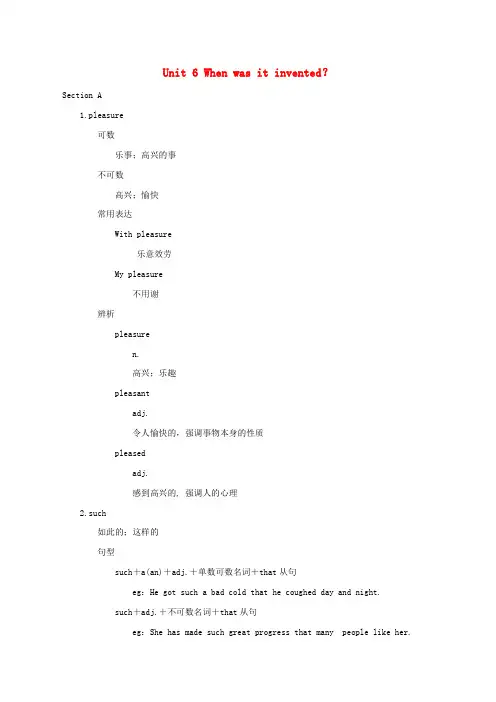
Unit 6 When was it invented?Section A1.pleasure可数乐事;高兴的事不可数高兴;愉快常用表达With pleasure乐意效劳My pleasure不用谢辨析pleasuren.高兴;乐趣pleasantadj.令人愉快的,强调事物本身的性质pleasedadj.感到高兴的, 强调人的心理2.such如此的;这样的句型such+a(an)+adj.+单数可数名词+that从句eg:He got such a bad cold that he coughed day and night.such+adj.+不可数名词+that从句eg:She has made such great progress that many people like her.such+adj.+名词复数+that从句eg:They are such interesting books that we all like them.辨析such修饰名词He is such a kind man.so修饰形容词或副词He is so kind a man.3.daily=every dayn.日报People's Daily《人民日报》4.mention提到;说到句型Don't mention it感谢道歉mention sb./sth.(to sb.)(向某人)提起某人或某事mention doing sth.提到做某事5.It is said that...据说……=People say that...相同结构It is reported that...据报道……It is supposed that...据猜测……It is believed that...人们认为……It's known that...众所周知……6.辨析take place指事先安排的事情eg: Great changes have taken place in our city over the years.happen指偶然发生的事情eg:An accident happened in that street.7.doubtwithout doubt毫无疑问;的确doubt sth.怀疑某事eg:No one doubts his ability.8.at a low price以低价eg:This sweater is on sale at a low price.9.translate翻译translate... into ...把……翻译成……eg:Don't translate everything into Chinese when you read English articles. Section B1.by mistake错误地;无意中eg:I took your bag by mistake.2.the Olympics=the Olympic Games语动词常用复数形式eg:The 30th Olympics were heldin London in 2012.3.divide...into把……分成……eg: The teacher divided us into four teams.4.stop句型stop ...from ...阻止……做某事eg: Nothing can stop China from being stronger and stronger.stop sb. from doing sth.= prevent sb. from doing sth.=keep sb. from doing sth.eg:Can you stop kids from playing Glory of Kings ?5.就近原则not only ... but also...neither...nor..既不……也不…… (两者都不)either...or...不是……就是……there be 结构6.look up to钦佩;仰慕=admireeg: Lots of kids look up to Li Yifeng nowadays.仰起头看……eg: The girl is so short that she has to look up to her elder sister.7.hero复数:+es以o结尾加es变复数的名词黑人(Negro) 英雄(hero)爱吃西红柿 (tomato) 炒土豆(potato) Section A1.pleasure可数乐事;高兴的事不可数高兴;愉快常用表达With pleasure乐意效劳My pleasure不用谢辨析pleasuren.高兴;乐趣pleasantadj.令人愉快的,强调事物本身的性质pleasedadj.感到高兴的, 强调人的心理2.such如此的;这样的句型such+a(an)+adj.+单数可数名词+that从句eg:He got such a bad cold that he coughed day and night.such+adj.+不可数名词+that从句eg:She has made such great progress that many people like her.such+adj.+名词复数+that从句eg:They are such interesting books that we all like them.辨析such修饰名词He is such a kind man.so修饰形容词或副词He is so kind a man.3.daily=every dayn.日报People's Daily《人民日报》4.mention提到;说到句型Don't mention it感谢道歉mention sb./sth.(to sb.)(向某人)提起某人或某事mention doing sth.提到做某事5.It is said that...据说……=People say that...相同结构It is reported that...据报道……It is supposed that...据猜测……It is believed that...人们认为……It's known that...众所周知……6.辨析take place指事先安排的事情eg: Great changes have taken place in our city over the years.happen指偶然发生的事情eg:An accident happened in that street.7.doubtwithout doubt毫无疑问;的确doubt sth.怀疑某事eg:No one doubts his ability.8.at a low price以低价eg:This sweater is on sale at a low price.9.translate翻译translate... into ...把……翻译成……eg:Don't translate everything into Chinese when you read English articles. Section B1.by mistake错误地;无意中eg:I took your bag by mistake.2.the Olympics=the Olympic Games语动词常用复数形式eg:The 30th Olympics were heldin London in 2012.3.divide...into把……分成……eg: The teacher divided us into four teams.4.stop句型stop ...from ...阻止……做某事eg: Nothing can stop China from being stronger and stronger.stop sb. from doing sth.= prevent sb. from doing sth.=keep sb. from doing sth.eg:Can you stop kids from playing Glory of Kings ?5.就近原则not only ... but also...neither...nor..既不……也不…… (两者都不)either...or...不是……就是……there be 结构6.look up to钦佩;仰慕=admireeg: Lots of kids look up to Li Yifeng nowadays.仰起头看……eg: The girl is so short that she has to look up to her elder sister.7.hero复数:+es以o结尾加es变复数的名词黑人(Negro) 英雄(hero)爱吃西红柿 (tomato) 炒土豆(potato)。
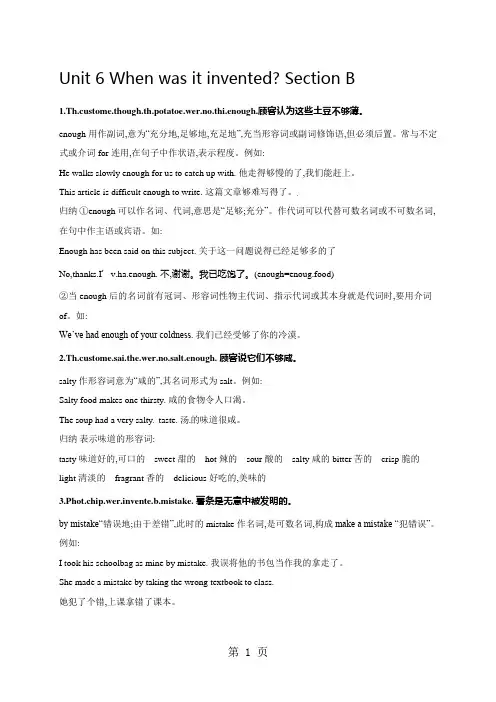
Unit 6 When was it invented? Section B1.Th.custome.though.th.potatoe.wer.no.thi.enough.顾客认为这些土豆不够薄。
enough用作副词,意为“充分地,足够地,充足地”,充当形容词或副词修饰语,但必须后置。
常与不定式或介词for连用,在句子中作状语,表示程度。
例如:He walks slowly enough for us to catch up with. 他走得够慢的了,我们能赶上。
This article is difficult enough to write. 这篇文章够难写得了。
归纳①enough可以作名词、代词,意思是“足够;充分”。
作代词可以代替可数名词或不可数名词,在句中作主语或宾语。
如:Enough has been said on this subject. 关于这一问题说得已经足够多的了No,thanks.I’v.ha.enough. 不,谢谢。
我已吃饱了。
(enough=enoug.food)②当enough后的名词前有冠词、形容词性物主代词、指示代词或其本身就是代词时,要用介词of。
如:We’ve had enough of your coldness.我们已经受够了你的冷漠。
2.Th.custome.sai.the.wer.no.salt.enough. 顾客说它们不够咸。
salty作形容词意为“咸的”,其名词形式为salt。
例如:Salty food makes one thirsty. 咸的食物令人口渴。
The soup had a very salty taste. 汤的味道很咸。
归纳表示味道的形容词:tasty 味道好的,可口的sweet 甜的hot 辣的sour 酸的salty 咸的bitter 苦的crisp 脆的light 清淡的fragrant 香的delicious 好吃的,美味的3.Phot.chip.wer.invente.b.mistake. 薯条是无意中被发明的。
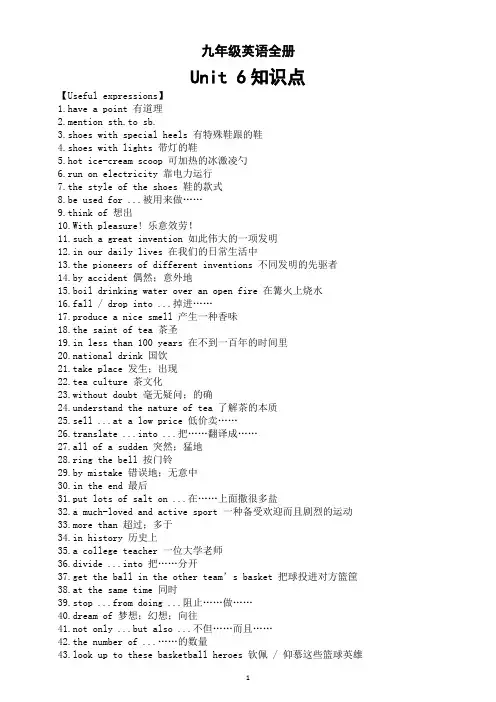
九年级英语全册Unit 6知识点【Useful expressions】1.have a point 有道理2.mention sth.to sb.3.shoes with special heels 有特殊鞋跟的鞋4.shoes with lights 带灯的鞋5.hot ice-cream scoop 可加热的冰激凌勺6.run on electricity 靠电力运行7.the style of the shoes 鞋的款式8.be used for ...被用来做……9.think of 想出10.With pleasure! 乐意效劳!11.such a great invention 如此伟大的一项发明12.in our daily lives 在我们的日常生活中13.the pioneers of different inventions 不同发明的先驱者14.by accident 偶然;意外地15.boil drinking water over an open fire 在篝火上烧水16.fall / drop into ...掉进……17.produce a nice smell 产生一种香味18.the saint of tea 茶圣19.in less than 100 years 在不到一百年的时间里20.national drink 国饮21.take place 发生;出现22.tea culture 茶文化23.without doubt 毫无疑问;的确24.understand the nature of tea 了解茶的本质25.sell ...at a low price 低价卖……26.translate ...into ...把……翻译成……27.all of a sudden 突然;猛地28.ring the bell 按门铃29.by mistake 错误地;无意中30.in the end 最后31.put lots of salt on ...在……上面撒很多盐32.a much-loved and active sport 一种备受欢迎而且剧烈的运动33.more than 超过;多于34.in history 历史上35.a college teacher 一位大学老师36.divide ...into 把……分开37.get the ball in the other team’s basket 把球投进对方篮筐38.at the same time 同时39.stop ...from doing ...阻止……做……40.dream of 梦想;幻想;向往41.not only ...but also ...不但……而且……42.the number of ...……的数量43.look up to these basketball heroes 钦佩 / 仰慕这些篮球英雄44.encourage sb.to do sth.鼓励某人做某事45.achieve their dreams 实现他们的梦想e up with 提出;想出47.lead to 导致【Target sentences】When was the telephone invented?I think it was invented in 1876.I think the TV was invented before the car.Think about how often it’s used in our daily lives.The pioneers of different inventions were listed there.But at that time, it wasn't used widely.How tea was invented by accident.The most popular drink in the world was invented by accident.9.The book describes how tea plants were grown and used to make tea.10.It is believed that tea was brought to Korea and Japan during the 6th and 7th centuries.11.The tea trade from China to Western countries took place in the 19th century.12.The Chinese are without doubt the ones who best understand the nature of tea.13.It is said that a Chinese ruler called Shen Nong was the first to discover tea as a drink.14.Potato chips were invented by mistake.15.The customer was happy in the end.16.Basketball was invented by a Canadian doct or …17.He was asked to think of a game that could be played in the winter.18.They need to stop the competing team from getting the ball into their own basket.19.Basketball has 3not only become a popular sport to play, but it has also becomea popular sport to watch.【Language points】1.changing the style of the shoesstyle /staɪl/ n. 样式;款式style在此处作可数名词。
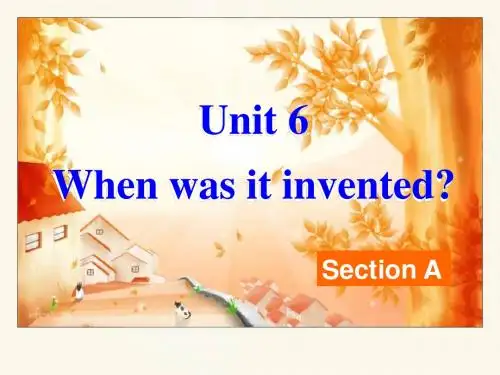

Unit 6 When was it invented?Section A1. invent v. 发明inventor n. 发明家invention n. 发明可数名词2. It’s used for scooping really cold ice cream. 它是用来舀很凉的冰激凌。
此句中be used 是被动语态形式,意为“被用来……”。
Be used for 意思是“被用来做……”,介词for表用途,后面加名词或动名词。
如:The key is used for locking the door. 这把钥匙是用来锁门的。
知识拓展:1)be used to do 表示“被用来做……”,used为动词过去分词,其中的to 为不定式符号,其后接动词原形,相当于be used for doing sth. 如:A hammer is used to drive in nails. = A hammer is used for driving in nails. 锤子是用来钉钉子的。
2)be used to (doing) sth. 表示“习惯于做……”。
如:He is used to living here. 他习惯于住在这儿。
3)used to do sth. 表示“过去常常干某事”He used to go to Beijing when be was young. 他年轻时常常去北京。
4)be used as 表示“把……用作……”,as 是介词,意为“作为”。
The piece of wood is used as a bench. 这块木头被用作凳子。
5) be used by 意为“被……使用”,强调使用者。
The car is used by our manager.3. operate用法:1)“操作”Can you operate the computer?2)“起作用,见效果” e.g. The sleeping pill operated at once.3)“经营,管理” e.g. The company operates ten factories.4)“动手术”operate on / upon sb. “给某人动手术”e.g. The doctor will operate on his mother next week.我认为,,比较好。
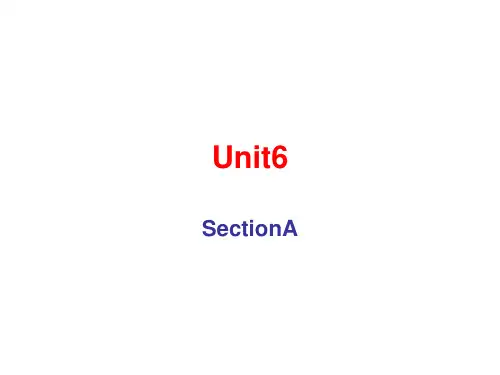
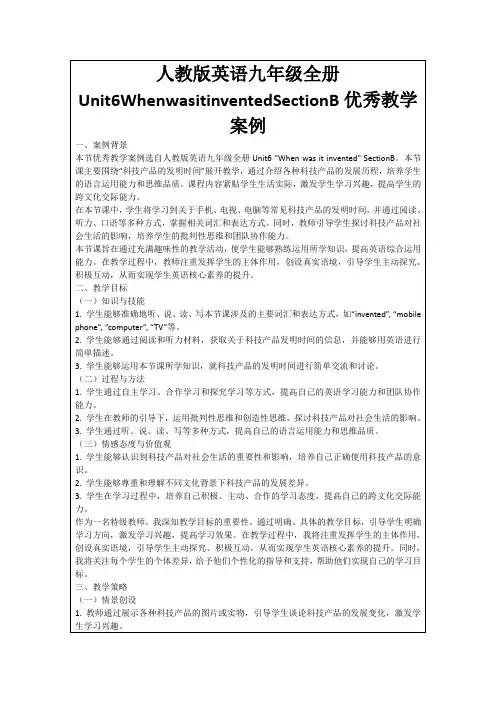
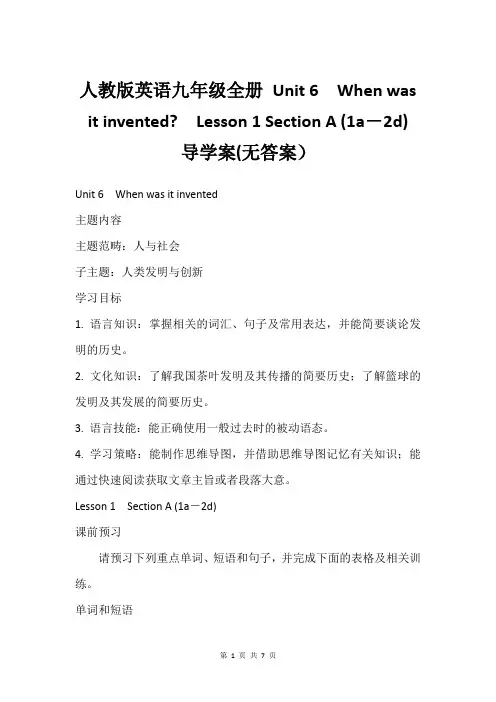
人教版英语九年级全册Unit 6 When was it invented? Lesson 1 Section A (1a-2d)导学案(无答案)Unit 6When was it invented主题内容主题范畴:人与社会子主题:人类发明与创新学习目标1. 语言知识:掌握相关的词汇、句子及常用表达,并能简要谈论发明的历史。
2. 文化知识:了解我国茶叶发明及其传播的简要历史;了解篮球的发明及其发展的简要历史。
3. 语言技能:能正确使用一般过去时的被动语态。
4. 学习策略:能制作思维导图,并借助思维导图记忆有关知识;能通过快速阅读获取文章主旨或者段落大意。
Lesson 1Section A (1a-2d)课前预习请预习下列重点单词、短语和句子,并完成下面的表格及相关训练。
单词和短语重点单词名词1. 鞋跟;足跟heel 2. 勺;铲子scoop 3. 电;电能electricity (adj.)电的;用电的electric 4. 样式;款式style 5. 项目;工程project 6. 高兴;愉快pleasure (adj.)令人愉快的pleasant 7. 拉链;拉锁zipper(=zip) 8. 网站website 9. 先锋;先驱pioneer动词10. 提到;说到mention形容词11. 每日的;日常的daily(短语)在我们的日常生活中in our daily lives兼词12. (v.)列表;列清单(n.)名单;清单list重点短语1. ……的款式the style of ... 2. 被用作…… be used for ... 3. 认为;想起think of 4. 考虑;思考think about 5. 似乎做某事seem to do sth. 6. 有道理have a point 7. 例如for example 8. 在那时at that time根据语境或提示,完成填空。
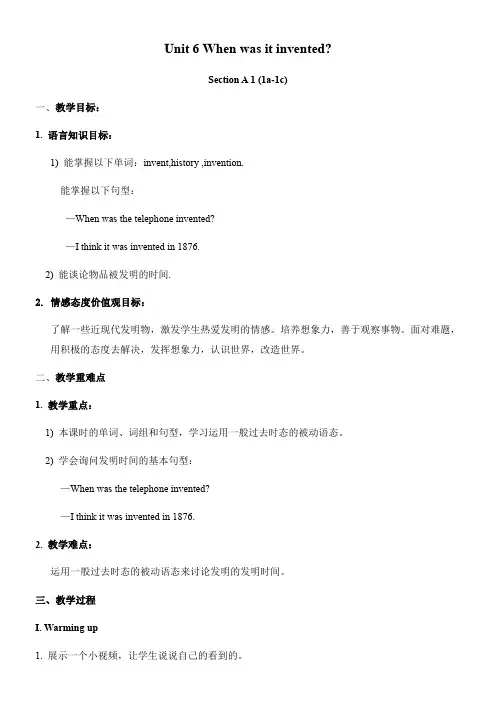
Unit 6 When was it invented?Section A 1 (1a-1c)一、教学目标:1. 语言知识目标:1) 能掌握以下单词:invent,history ,invention.能掌握以下句型:—When was the telephone invented?—I think it was invented in 1876.2) 能谈论物品被发明的时间.2. 情感态度价值观目标:了解一些近现代发明物,激发学生热爱发明的情感。
培养想象力,善于观察事物。
面对难题,用积极的态度去解决,发挥想象力,认识世界,改造世界。
二、教学重难点1. 教学重点:1) 本课时的单词、词组和句型,学习运用一般过去时态的被动语态。
2) 学会询问发明时间的基本句型:—When was the telephone invented?—I think it was invented in 1876.2. 教学难点:运用一般过去时态的被动语态来讨论发明的发明时间。
三、教学过程I. Warming up1. 展示一个小视频,让学生说说自己的看到的。
2. 展示一些近代发明的图片与近代发明物。
T: Do you know what these inventions are?S1: It’s a car.S2: It’s a telephone.S3: It’s a television.T: Do you know when they were invented?S1: I think the TV was invented in 1927.S2: .....Ⅱ. Talking1. Look at the pictures in 1a. Discuss with your group, in what order do you think they were invented? Try to number them [1-4].2. Ss discuss with their partners and number the pictures.3. Talking about the inventions:A: I think the TV was invented before the car.B: Well, I think the TV was invented after the TV.Ⅲ. Listening (1b)1. T: Tell Ss look at the pictures and years on the left.2. Play the recording for the Ss to listen.3. Ss listen to the conversation and try to match the invention with the proper year.4. Play the recording again.5. Check the answers.IV. Pair work (1c)1. Ss try to remember the inventions and the year.2. Student B, cover the dates. Student A, ask Student B when the things in the picture in 1b were invented. Then change roles and practice again.3. Let some pairs ask and answer in pairs.e.g. A: When was the telephone invented?B: I think it was invented in 1876.…V.Homework1 .make conversations with your partner(A.B).write down the conversation in 1c(C).2.Finish the exercise in exercise book.。
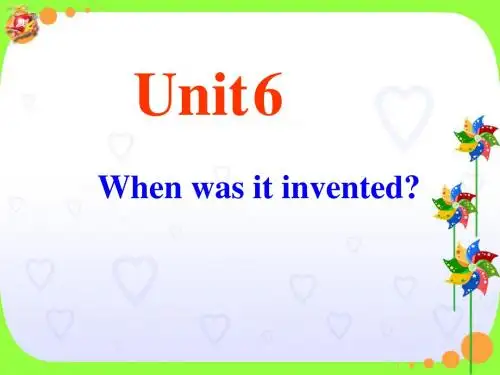
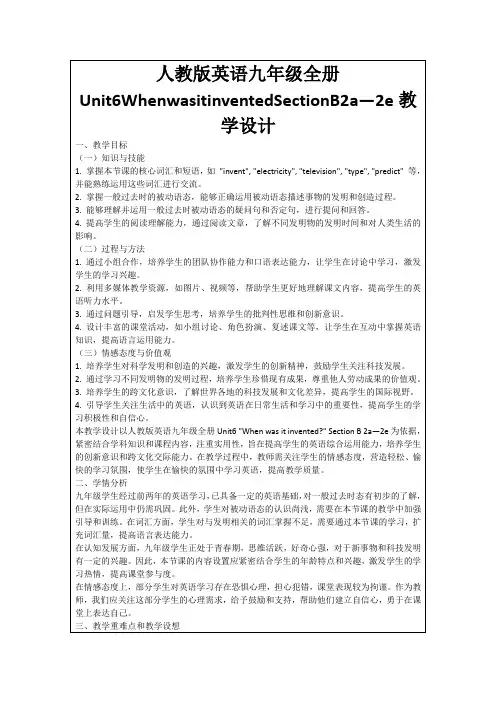
哈博教育哈博教育咨询有限企业HaBoEducation&AdvisoryCo. ,Ltd.教师学生时间和时段2016年月日:—:)(学科英语年级九年级上教材名称人教版讲课题目Unit6Whenwasitinvented?课次第()次课【短语概括】1.thestyleof⋯⋯的式17.allofasudden忽然;猛地2.suchagreatinvention这样了不起的一明18.bymistake地;无心中3.beusedfor被用于⋯..19.intheend最后4.byaccident有时;不测处cookcalledGeorgeCrum一个名叫治·卡拉姆的厨5.thinkof/about想/考21.morethan多于;超6.fallinto落入/堕入22.theOlympics奥林匹克运会7.inourdailylife在我的平时生活中23.divide⋯into⋯把⋯分红⋯8.sometime一段24.atthesametime同9.thesaintoftea茶圣25.stop⋯fromdoing⋯阻挡⋯做⋯10.lessthan少于;不到26.dreamof/about梦想;神往11.takeplace生;出27.notonly⋯butalso⋯不只⋯.并且⋯12.inthe19th century在十九世28.thenumberof⋯⋯的数目13.thepopularityof⋯⋯的普及29.moreandmore愈来愈⋯.14.withoutdoubt毫无疑;确实30.lookupto佩;敬慕15.atalowprice以廉价31.achieveone’sdreams某人的梦想16.translate..into..把..翻成⋯32.takenotes笔to致【用法集萃】1.Itissaidthat⋯据⋯isbelievedthat⋯人⋯.3.asksb.(not)todosth.要求某人(不要)做某事4.teachsb.todosth.教某人做某事5.needtodosth需.要做某事sb.todosth鼓.励某人做某事7.beusedtodosth.被用于做某事SectionAl.IthinktheTVwasinventedbeforethecar. 我是在小汽从前被明的。
学科English 课时 3 年级 9 课题Unit 6 When was it invented? 3/5
教学要求1. Learn the new words: sweet, crispy, salty, sour, by mistake.2. Learn to talk about the history of inventions.
教学重难点1.Train the students' speaking and
listening
skills with the target language.2.Teach
the students
to use the new vocabulary correctly.
教
法
合作
学习
法
交际
型教
学法
分组
活动
法
教学过程及问题情境学生活动
设计
意图
Step 1 Revision
Have a free talk. Ask the students to practice talking to each other。
Step 2 Presentation
Ⅰ.1a Practice
talking to each other。
复习
上节
课所
学内
1. Read the four words and ask students to repeat them. Give them a minute to read and write the words. Then tell the students they are adjectives and they are used for describing things. For example: The apple is sweet and sour.
2. Get the students to describe the things with the given adjectives. Some food have more than one word.
3. Check the answers.
Ⅱ1b Ask the students to describe how food taste and finish 1b.
Ⅲ.2a
1. Let students describe how potato chips taste and describe how helpful the potato chips.
2..Ask the students to listen to a story about the invention of the potato chips and circle T or F.
3. Check the answers.
Ⅳ. 2b Write the words under the
correct
pictures
Listen and circle T or F.
Listen again
and complete
the sentences.
Work in pairs.
Role play the conversation
about the
invention of
the potato
chip. Use the information
from 2a and 2b.
容,
巩固
所学
知
识。
认知
一些
形容
词,
为听
力做
准
备。
利用
所学
语
言,
创造
新的
对
话,
培养
1.Listen again and complete the sentences.
2. Check the answers.
Ⅴ.2c Pairwork
This activity provides guided oral practice using the target language. Ask the students work in pairs. Role play the conversation about the invention of the potato chip. Use the information from 2a and 2b.
Step 3. Summary 学生创新思维。
作
业布置1. Learn the new words: sweet, crispy, salty, sour, by mistake.
2. Learn to talk about the history of inventions.
教学反思
合理安排和修改教学结构,使学生在老师指引下学会学习,发挥自己的能力,在玩中学,在学中用,使教学具有有趣性。
课堂教学由原来的学生不想说,不会说到现在的学生愿意说,愿意表演。
教学的效果大大提高了。
另外采用引导和模拟情景的学习方式使学生成为学习的主体。
让学生在真实有趣的环境中学习,学生对英语的兴趣提高了。
对于不懂的地方,他们也会主动的要求学习。